
Search
The Renewable Energy site for Do-It-Yourselfers
An Initial Test of
a Simple, Nighttime, Evaporative+Radiation Cooling Panel
AND -- Solar Heating and Cooling System With the Same System
|
After re-reading some of Steve Baer's
material on the "Double
Play" solar heater and cooler, and the FSEC's work on radiation home
cooling, I got to wondering if the same collector that I prototyped for the
simple pool heating might also be put into service as a night time radiator
to cool water. The idea being that water from a storage tank would
be
pumped over the radiator at night, where it is cooled by radiation and
evaporation. The chilled water would stored in the tank would be used for
space cooling the following day.
The cooler works through a
combination of radiating heat to the cool night sky and cooling due to
evaporation of a small part of the water flowing down the collector.
The results from a few overnight runs
of a prototype of the cooler are shown below, along with some thoughts on how
such a system might be used in practical applications.
Directory:
|
|
A First Test
The pictures show the prototype test
setup. The radiator is 0.02 thick aluminum with pre-formed grooves that I
used for water channels.
Water is pumped from the 41 gallon
tank by a submersible pump in the tank to the manifold along the top of the
radiator. A small stream of water from the manifold squirts out onto the
collector surface at each water channel, and also half way between each water
channel.
The water is collected at the bottom
of the radiator by a gutter that returns the water to the tank.
The tank is a galvanized steel stock
tank that is somewhat insulated.

Picture of the simple prototype: The
brown aluminum
absorber/radiator is exactly the same one used for the
pool collector
prototype.
The cold water storage tank is under the insulation to the left. A
submersible pump in the tank pumps water to the manifold
across the top of the radiator.
The manifold has multiple holes across the top that deliver water to the top of
the radiator.
The water runs down the radiator
(cooling on the way), and is collected by the grey gutter along the bottom,
which takes it back to the
the tank about 3F cooler than when it
left.
The separate piece of aluminum toward
the bottom right was used to measure how far below ambient a radiator with no
water
flowing over it would get.
The radiator surface temperatures were measured with an IR thermometer and
surface mount thermocouples stuck to the back side of the radiator.
The water temperatures were recorded using thermistor style sensors on an Onset
Computer logger. Relative humidity and ambient temperature were recorded
with a similar Onset logger in a shaded location a few feet away.
Wind velocity at the surface of the radiator was measured with a simple
Dwyer vane type velocity meter.
The test plots and data below show at
least the following:
- The radiator surface maintains
a temperature about 10F to 13F below the ambient air temperature. This
is presumably due to its losing heat by radiation to the sky. The
section of radiator without water flow ran about 5F cooler yet.
- The radiator was able to cool
the 0.05 gpm/sqft stream of water by about 2.5F to 3F during its travel down
the radiator. Some cooling is due to evaporation and some to radiation
-- not sure how much to each?
- Over the 12 hour night, the
radiator cooled the water in the tank from 69F down to 49.5F, or 19.5F.
This amounts to 467 BTU per sqft of radiator.
This method of cooling benefits from
the low humidity, clear night skies, and rapid drop in ambient temperature that
are common to this area (SW Montana), and would be less effective in areas with
higher night temperatures, high humidity, high winds, and cloudier skis.
Note in the plot how rapidly the radiator/cooler
turns into a solar collector water heater when the sun gets on it at 8am --
clearly showing it can do both under the right conditions.
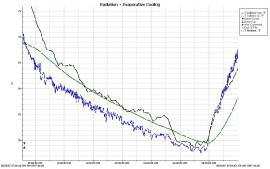
Click on plots to enlarge
The plot below shows the night of
8/29/07 -- a mostly clear night with light winds.
It shows temperatures for ambient,
collector input (tank), and collector output.
T ambient air Black
T collector inlet Green -- same as
the tank temperature
T collector out Blue -- temperature
of cooled water returning to tank
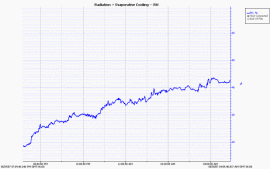
Relative Humidity for same period.
Additional data recorded during test:
|
Radiation Cooling Test 8/29/07 |
|
|
|
|
|
|
|
|
|
|
|
Time |
Tank Depth (in) |
Wind (fpm) |
Sky |
T absorb F (2) |
T raditor F (3) |
|
7:10 PM |
11.625 |
50 |
Clear(1) |
|
|
|
8:43 PM |
11.375 |
125 |
Clear(1) |
55 |
50 |
|
6:24 AM |
11.125 |
80 |
Clear(1) |
43 |
38 |
|
|
|
|
|
|
|
|
|
|
|
|
|
|
|
(1) some forest fire smoke haze |
|
|
|
|
(2) Temperature of absorber surface midway between water channesl --
surface mount thermocouple - deg F |
|
(3) Temperature of alum sheet with no water flow -- surface mount
thermocouple - deg F |
Wind speed is measured at the surface
of the absorber -- typically less than 2 mph on the surface on this night.
Flow rate was 0.7 gpm, this is 0.05
gpm/sqft of collector.
Collector is about 45 inches by 46
inches -- about 14.25 sqft.
The tank is a galvanized metal stock
tank, 45 inches long by 20.5 inches wide with rounded ends (this is our dogs
cool off tank, and she is a little pissed a me for stealing it).
It was insulated with 2 inches of
polyiso underneath and a lid of 2 inch polyiso.
The sides were insulated with 2
layers of Reflectex aluminized bubble wrap style insulation.
The tank holds 3.6 gallons per inch
of depth.
Start volume = 41.85 gallons
End volume = 40.05 gallons
Water used overnight = 1.8 gallons
The pump is a submersible and sits at
the bottom of the tank. It draws 16 watts (55 BTU/hr) -- an outside the
tank pump that does not lose all its heat to the water might improve performance
a little bit -- maybe 8% at most?
Cooling:
The 41 gallons (340 lbs) cooled from
69F down to 49.5F overnight -- a drop of 19.5F degrees.
This is (340 lb)(69F - 49.5F) (1
BTU/lb-F) = 6630 BTU, or 467 BTU per sqft of collector.
The cooling rate per sqft of
collector, per hour of operation was:
BTU/sqft-hr = (40.5
gal)(8.33 lb/gal)(1.43F/hr)(1 BTU/lb-F) / (14.25 Sqft) = 33.8 BTU pers hour
per sqft of collector.
Where 1.43 F is the average rate
of cooling of the tank water per hour of operation from the plot.
So, this is a sort of figure of
merit for comparing radiator cooling efficiency for different radiator
consructions.
A 200 sqft radiator would then give
about 93,000 BTU of cooling -- kind of a like a 1 ton AC operating for 8 hours.
The COP is about (6630 BTU)/( (16
w)(10hr)(3.412 BTU/ wh) ) = 12.1 (around 41 SEER?)
This seems good to me, and the pump
was not chosen for efficiency, so one might do even better.
Several additional night long runs
were done with similar results.
This thought just struck me: Suppose you transferred all of the water
from the storage tank to a fairly shallow and fairly large basin, and just let
it sit under the sky overnight, then in the morning, transfer it back to the
storage tank. How would the cooling compare to the scheme described above?
One of these transfers could be gravity flow.
Click pictures to enlarge
Tan and submersible pump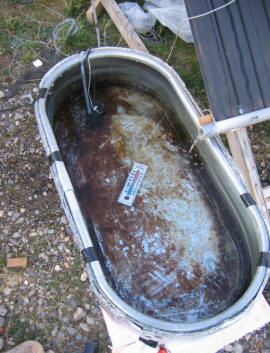 |
Top manifold with water going.
 |
Test Observers
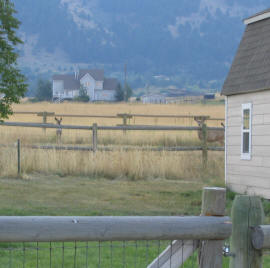 |
Can This Be
Used In A Practical Home Cooling System?
To make a full home cooling system,
you also need a way to distribute the coolth that has been collected in the
storage tank to the house on the following day. In my case, I am thinking
of using the
system that I built to provide solar heating in the winter. This
system has a set of solar heating collectors that heat the water in a 500 gallon
storage tank. The heated water in the storage tank is in turn pumped
through the radiant floor piping when the house needs heat.
For cooling, I am thinking of using
the same tank and radiant floor system to store and deliver coolth instead of
heat.
The south roof/wall of the garden
shed have the solar heating collectors on them. These (I believe) would
not make good radiators due to the IR opaque glazing used on them. I
think that the the north roof of the same garden shed could be used for the
cooling radiators. If the cooling rate per sqft that the test shows can be
replicated, the shed roof will provide plenty of area to cool the water in the
500 gallon tank. I am thinking about a manifold along the roof ridge line
to deliver water from the tank to the roof. The water would flow down the
roof slope, cooling as it goes, and then be collected by a gutter, and directed
back tot the tank. I believe that the same pump that is used to pump water
to the collectors could be used to water the roof radiator.
If the 500 gallon tank can be cooled
by the 20F that the test indicates, then it would store about 83000 BTU of
coolth. This would provide us with the same effective cooling as running a
1 ton AC for 7 hours a day.
click on pictures to enlarge
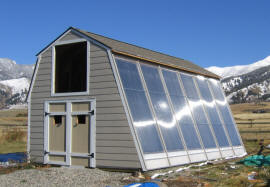
The solar shed with collectors on the
south wall.
The storage tank is inside the shed.
The cooling radiators would make use of the two north facing roof slopes -- in
excess of 200 sqft of radiator area.
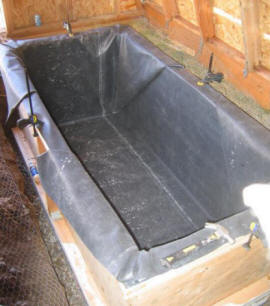
The tank inside the garden shed under
construction.
The cooling radiators could store cooth in the same tank that the collectors
store heat.
The stored coolth is piped to the
house via buried pipes, and circulated through the radiant floor.
I'm starting to think that this might
just work.
Total cost of adding cooling would be
a few dollars worth of pipe and valves, and some kind of timer or reverse
differential controller to control the pump.
I realize that radiant floors are not
ideal for cooling, but in our case where cooling demands are not high, and
humidity is low, I think the radiant floor should be OK.
Potential Dual
Use Heating and Cooling Systems
One might even envision a system in
which collector panels similar to
trickle style
swimming pool panel are glazed during the winter for efficient heat
collection (like a
Thomason trickle collector), and then the glazing panels are
removed in the summer to provide efficient evapro-radiative cooling in the
summer. It might seems a bit impractical to remove the glazing
panels each year, but I was struck by how easy this was on the system I have
with the large but lightweight twinwall polycarbonate panels. I had to
remove and reinstall all 6 panels once to fix a problem, and the round trip on
240 sqft of glazing only took about an hour -- I think this could be improved if
it was designed to make the changeover easy -- I think this could become a 15
minute job with good design. This would make a system that could be used
equally well for both heating and cooling even in climates with quite cold
winters. It would also be dirt cheap to build -- perhaps $3 per sqft for
the collectors.
This is a less elegant solution than
the "double play" system, but the addition of the seasonally removable glazing
might allow it to work in colder climates.
Another dual use system would use the
trickle style
swimming pool collector to heat the swimming pool during the day, and during
the same night use the same collector to chill water in a storage tank that
could then be used for house cooling on the fooling day.
Any thoughts or comments on any of
this would be most welcome --
Gary
Gary 9/10/07
9/6/2010 -- updated to include BTU/sf-hr
performance of the metal radiator.



